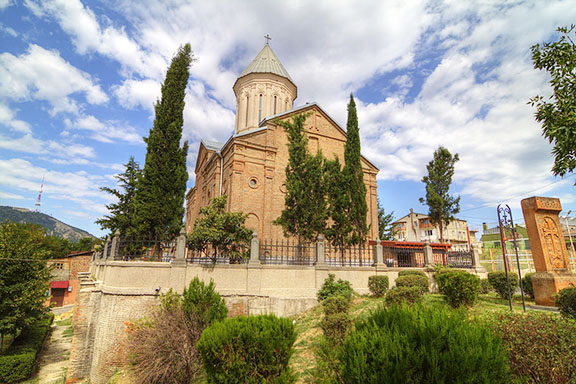
Tensions Between Georgian and Armenian Churches Escalate
Publication: Eurasia Daily Monitor Volume: 11 Issue: 146
By:

The Ukrainian events have demonstrated that when religious passions enter into a conflict between two nations, those passions can divide closely related peoples as well as transform the conflicts from ones amenable to a negotiated compromise into absolutist struggles where a non-violent settlement is far less likely (see Hot Issue, August 8). Therefore, a recent escalation in tensions between the Georgian Orthodox Church and the Armenian Apostolic Church merits closer attention than a superficial glance might suggest.
These two Orthodox Churches are among the most ancient in the world, going back nearly to the dawn of Christianity, and have played a key role in the formation of their respective nations. Significant doctrinal differences between the two are substantial, but these have seldom been an obstacle to communion and became less significant for the laity during Soviet times when few Georgians or Armenians could identify these theological points of contention. In the difficult post-Soviet histories of the two peoples, the role of their respective churches as a source of identity, if not doctrine, has become even greater.
The tensions inherent in that relationship reached a new level of seriousness following a clash at the Surb Etchmiadzin Armenian Church, located in the Georgian capital of Tbilisi, on July 19. What happened appears to have been relatively petty, but is now mired in a dispute not only between the two churches but between the two countries. According to the Georgian side, a Georgian woman protested that a car belonging to an Armenian clergyman was blocking her way, several Georgians tried to help her, and then several Armenians attacked them. According to the Armenian side, the woman behaved badly, shouting imprecations at the Armenians, and converted an incident that might have been quickly forgotten into an ethnically and even “racially” charged clash involving upwards of 50 people (asbarez.com, July 21).
The local diocese of the Armenian Church issued a statement demanding that the Georgian authorities investigate what they called “a hate crime.” That was followed by a call from the Armenian foreign ministry for a “thorough and unbiased investigation” by Tbilisi, a denunciation of ethnic and religious intolerance in Georgia by the Holy See of Etchmiadzin, and a condemnation of the incident by Armenian Justice Minister Hovhannes Manukyan (asbarez.com, armenpress.am, July 21; aysor.am, July 24).
According to Georgian commentator Georgy Kalatozishvili, such reactions to this incident have less to do with the incident itself than with underlying problems “between the two states and two communities,” many of which, he argues, are traceable to discord between the two Churches over the construction of a Georgian cathedral in Tbilisi in 1989. These tensions have been simmering ever since, Kalatozishvili contends (Vestnik Kavkaza, July 30).
The construction of the Georgian cathedral became a problem for the Armenians because its site was either next to or, according to Armenians, occupied part of what has long been the Armenian cemetery there. That conflict was ultimately resolved, though it later sparked another: the Armenian Church sought to recover its church property in Georgia after the fall of Communism, but the Georgian Church could not agree on which buildings belonged to whom. A matter of particular dispute was the Surb Norashen church in the Georgian capital that both sides claimed.
Kalatozishvili says that Armenian diplomacy—which, according to him, is “traditionally” more clever than the Georgian—sought agreement that if that church was not handed over to the eparchate of the Armenian Apostolic Church, “it would not be a working church of the Georgian Orthodox Church either.” But despite that accord, Armenian churchmen continued to visit the “church” and conduct services of various kinds, infuriating the Georgians.
On occasion, this dispute has escalated to the level of the heads of the churches, but they failed to reach an accord when they could not agree on how to address one another. Eventually, the matter even reached the presidential level. Former Georgian president Mikhail Saakashvili stepped in and sought to solve the dispute by giving the Armenian Church in Georgia legal equality with the Georgian Church. The Georgian hierarchy retaliated by establishing an Agarak-Tashir eparchate, which includes a territorial part of Armenia that the two countries fought over in 1918. The Tbilisi church says that it has the right to do so because there are Georgian Orthodox congregations there and they must be part of the Church. The Armenian Church leadership, in contrast, insists that Georgia has no legitimate claims to any parishes there (Vestnik Kavkaza, July 30).
Bidzina Ivanishvili, the billionaire founder and leader of the ruling Georgian Dream coalition, then offered to restore all the Armenian churches on the territory of Georgia with his own money. But the Georgian Orthodox Church hierarchy refused to allow this. Even if the Georgian Church had stepped aside, Kalatozishvili says, Ivanishvili’s offer would not have solved the issues between the two Churches. Consequently, the situation remains tense, and small clashes have the potential to divide the two faiths, the two peoples and even the two countries.




